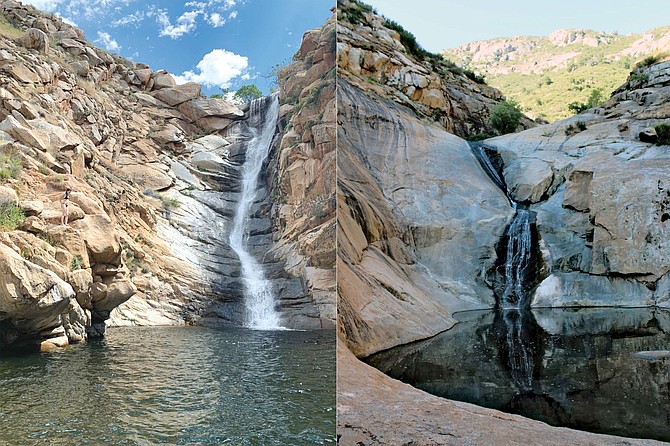 Facebook
Facebook
 X
X
 Instagram
Instagram
 TikTok
TikTok
 Youtube
Youtube

San Diego County’s Waterfalls, swollen with runoff and snowmelt from recent storms, should be at their very best during the next month or two. Three of the most accessible are: Green Valley Falls at Cuyamaca Rancho State Park; the falls below the first palm grove in Borrego Palm Canyon (Anza-Borrego Desert State Park); and the falls at the midpoint of Los Peñasquitos Canyon Preserve — a three-mile walk from either its east or west entrance. Hikers and climbers can explore many other waterfalls (some with heights up to 100 feet) in remote areas of the county.

Large Ocean Swells and Wild Surf conditions occurring during San Diego’s winter season can leave certain area beaches partially or wholly denuded of sand. The powerful waves pull sand off the beach and move it into deeper waters off shore, leaving behind deposits of rounded cobbles where sand has been removed. During spring and summer, gentle wave action returns much of the sand, usually in time for the arrival of summer tourists. Artificial sand replenishment projects are usually in the works, too, whereby sand dredged from waters off shore is transported back to the shoreline.

The California Brown Pelican displays its most colorful plumage on its head and neck from late December through February in anticipation of the March-April breeding season. Brown pelicans typically stay in flocks, and can often be seen flying in “V” formation along the coast. The brown pelican can spot a fish from heights of 70 feet and dives headfirst into the water to grab its prey. No other known pelican uses this technique to catch fish.


San Diego County’s Waterfalls, swollen with runoff and snowmelt from recent storms, should be at their very best during the next month or two. Three of the most accessible are: Green Valley Falls at Cuyamaca Rancho State Park; the falls below the first palm grove in Borrego Palm Canyon (Anza-Borrego Desert State Park); and the falls at the midpoint of Los Peñasquitos Canyon Preserve — a three-mile walk from either its east or west entrance. Hikers and climbers can explore many other waterfalls (some with heights up to 100 feet) in remote areas of the county.

Large Ocean Swells and Wild Surf conditions occurring during San Diego’s winter season can leave certain area beaches partially or wholly denuded of sand. The powerful waves pull sand off the beach and move it into deeper waters off shore, leaving behind deposits of rounded cobbles where sand has been removed. During spring and summer, gentle wave action returns much of the sand, usually in time for the arrival of summer tourists. Artificial sand replenishment projects are usually in the works, too, whereby sand dredged from waters off shore is transported back to the shoreline.

The California Brown Pelican displays its most colorful plumage on its head and neck from late December through February in anticipation of the March-April breeding season. Brown pelicans typically stay in flocks, and can often be seen flying in “V” formation along the coast. The brown pelican can spot a fish from heights of 70 feet and dives headfirst into the water to grab its prey. No other known pelican uses this technique to catch fish.
Comments